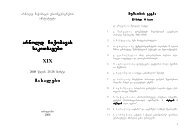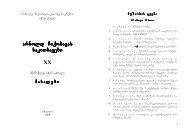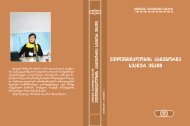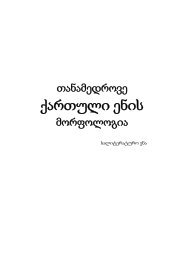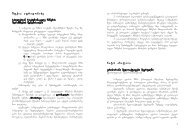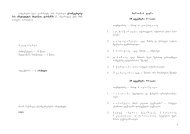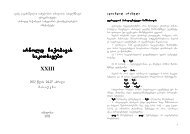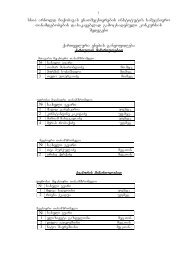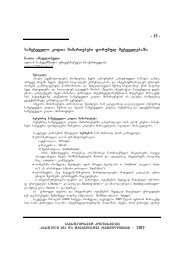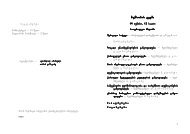5 r. a b a S i a (Tbilisi) bgeraTSesatyvisobis erTi rigisaTvis qarTvelur ...
5 r. a b a S i a (Tbilisi) bgeraTSesatyvisobis erTi rigisaTvis qarTvelur ...
5 r. a b a S i a (Tbilisi) bgeraTSesatyvisobis erTi rigisaTvis qarTvelur ...
You also want an ePaper? Increase the reach of your titles
YUMPU automatically turns print PDFs into web optimized ePapers that Google loves.
M . A g l a r o v (Makhachkala)<br />
A Phenomenon of Ethnolingual Manyfoldness in Daghestan<br />
(to the research of the causes of ethnic divergent evolution<br />
and integration)<br />
The ethno-linguistic plurality is one of the brightest features of the Caucasus,<br />
especially of Daghestan, and at the same time it is its age-old secret. The<br />
previous ideas of the causes of multilingual system in Daghestan (division of<br />
landscape, immigrations) are not improved.<br />
The ethnic and appropriately linguistic situation in Daghestan (about 30<br />
languages and 100 dialects) is a production of the unique multi-partial (polystructural)<br />
political system and is equal to it, so as such small units like free<br />
communities and even some communities which had had the structure of civil<br />
communities before Daghestan joined Russia.<br />
In Highland Daghestan there was founded an association of micro-political<br />
formations with their unions – free communities which had their own territory<br />
with overall possessive and administrative rights, that is territorial and political<br />
sovereignty. Such a mosaic of social-political autonomous units – free<br />
communities including political formations of feudal type which had existed on<br />
this territory for the last one and a half – two thousand years – turned out to be<br />
enough to found ethnic communities with there own languages, dialects and<br />
twangs within these formations.<br />
It would be a mistake to search for the situation of the political consolidation<br />
for such interethnic communities as the whole regions united by the language<br />
family or known in ethnography as historic-ethnographic areas. These levels<br />
are out of political situations and are predestined by the common ways of ethnic<br />
genesis. But when we approach to the more detailed ethnic map, the importance<br />
of the factors mentioned here rises and in some cases they obtain the full priority.<br />
The leading role of the political start in the process of ethno-lingual dissociation<br />
or integration is not universal and the ability of the political organization<br />
of the society to form autonomous ethno-cultural units (to an ethnographic effect)<br />
isn’t realized in all cases but only under the certain historic conditions, in<br />
the certain system of social relations at the certain level.<br />
25



